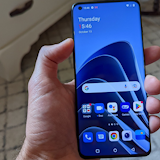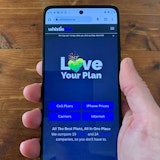 The Nokia Lumia 920 is Nokia’s first flagship device for the new Windows Phone 8 platform. Complete with Nokia’s increasingly iconic unibody polycarbonate design, ClearBlack HD display technology and the new PureView camera, the Lumia 920 has a good chance of being the best Windows Phone yet.
The Nokia Lumia 920 is Nokia’s first flagship device for the new Windows Phone 8 platform. Complete with Nokia’s increasingly iconic unibody polycarbonate design, ClearBlack HD display technology and the new PureView camera, the Lumia 920 has a good chance of being the best Windows Phone yet.
We loved its predecessor, the Lumia 900, when we reviewed it last year but can the Lumia 920 live up to the family name? We got a hold of one to find out in our very own Nokia Lumia 920 review.

Physical Design of the Nokia Lumia 920
First impressions of the Lumia 920 can range from playful to imposing, depending on the color scheme in question. As with the Lumia 820, the 920 is currently available in yellow, red, black, white and, in some circumstances, grey. We’ve remarked many times on our love for Nokia’s colourful approach to smartphone design, but this time around we only managed to get a plain black model.
While definitely more imposing than yellow, red or white, the black Lumia 920 is still an attractive and interesting device. Despite its almost identical design to the Lumia 900, most buyers should find the 920 to be fairly unique in shape and style. The unibody manufacturing creates a smooth appearance that we believe contrasts well with the sharp angles at the top and bottom of the handset.
The polycarbonate also feels great in the hand, although probably more so with the black model than the others. This is because the black Lumia 920 has a matte finish; something we find adds to grip and tends to look a bit more classy than the gloss finish found on other models. Still, the glossy options have a feeling of solidity that can be lacking in normal plastic or glass phone casings.
We do feel that overall the Lumia 920 is a bit big compared to the size of its screen. In fact, its dimensions are very similar to that of the Galaxy S3, but where the GS3 has a 4.8 inch display, the Lumia 920’s measures at just 4.5 inches. This may sound like nit-picking on paper, but the end result is definitely noticeable in person.
Not only this, but the Lumia 920 is quite thick and heavy as well. With a depth of 10.7mm and a weight of 185g it’s one of the thickest, heaviest smartphones we’ve used in quite a while.
This certainly made for a mixed first impression for us, as we love the look but were more than a little confused at the extra space around the display, thickness of the phone and overall weight. Still, the Lumia 920 feels like a solid device and it really does have a much more interesting design than most smartphones, especially if you go for a colorful option.
We also found that we adjusted to the weight and size fairly quickly and after a couple of weeks barely noticed it. Even so, we would have to say that the size and weight of the Lumia 920 is definitely its weakest point.
 Display and UI
Display and UI
The Lumia 920’s display is one of the areas in which it differentiates itself from its little cousin, the Lumia 820. The 920’s 768x1280 AMOLED ClearBlack display is just gorgeous. Colors are incredibly vibrant, whites are clear and blacks are nice and inky. Solid black tones are important in the Windows Phone interface, as much of the design relies heavily on a black background.
The high resolution provides 332 pixels per inch (ppi), which is just a little more than the Retina Display of an iPhone, although not by too much. Spreading this kind of crisp quality over a 4.5 inch screen really is fantastic and provides a wonderful visual experience.
Humerously, one area where the resolution doesn’t really matter is the general Windows Phone 8 interface. WP8, much like its WP7 predecessor, utilizes Live Tiles for its Start Screen. Seeing as squares are fairly easy to render in just about any resolution, a ppi of 332 isn’t really necessary. That’s not to say that HD is wasted in WP8; browsing, test rendering, video, pictures, games and all manner of apps still benefit hugely, but the general interface looks very much the same on a 480x800 screen as on an HD model.
Anyone upgrading from Windows Phone 7 will love the new WP8 UI, as should a fair few iOS and Android users as well. While we liked the Live Tiles on WP7 and thought it quite beautiful, Windows Phone 8 seems to have kept everything we loved and improved everything we only just liked.
The new customisable Live Tile system, whereby the user can resize tiles, is much better than one might expect. The ability to fit so many more tiles on a single screen means significantly less vertical scrolling. Microsoft has also ditched the pointless black bar on the right side of the screen in order to free up more real estate. This comes together to provide a user interface that feels as though it’s graduated from fledgling to fully-operational.
The added value of extra customisation helps to give the user a sense of uniqueness about the phone. Where everyone’s WP7 screen looked almost identical at first glance, barring color theme and background, the WP8 multi-sized tiles create the feeling of ‘this is my phone’, rather than ‘this is a Windows Phone’.
Beyond the Start Screen WP8 is very similar to WP7 in many respects, except it’s faster, smoother, has support for higher resolutions and more powerful CPUs, and utilizes Nokia Maps as standard instead of Bing Maps. This last point is a very good thing, as Nokia Maps is possibly second only to Google Maps in terms of mobile Maps services.
As usual, the artistic theme of WP8 is carried on through its services and apps, meaning that 3rd party apps like Facebook and Twitter end up looking gorgeous when put next to their iOS or Android equivalents. In fact, Facebook and Twitter in particular almost make their aforementioned counterparts look like something from a previous decade in terms of aesthetics. The difference is almost that of between Windows 7 (or Windows 8 for you early adopters) and Windows XP.
Nokia Music is basically the same as regular old Windows Phone Music, except with a twist. Gigs is a screen in the music app that displays nearby live gigs in your area, both current and upcoming. It’s an absolutely fantastic idea and acts as a good reminder that live music actually happens all the time. Or at least it does if you live in a well-populated metro area.
While the Gigs section still isn’t as comprehensive as it could be, we felt as though it had a bit more information than the last few times we’ve used it. Whether this is because Nokia has employed more staff to update its data, or because more venues are starting to cooperate with Nokia Music as a way of getting larger audiences, the concept seems to be spreading.
Even people who don’t watch live music might find they like this service. I personally found that I ended up considering live music as a viable option for a night’s entertainment, I even attended a few performances. This is because, while I would normally not bother looking up live gigs in my area, when it’s cropping up on my music app all the time it’s easy to notice when there’s a gig just down the road tomorrow at 8pm, so what’s the harm in giving it a go?
 Lumia 920 and the PureView Camera
Lumia 920 and the PureView Camera
First and foremost: our very own Pete Ottery has already done an in-depth camera comparison/review by pitting the Lumia 920 PureView shooter against the iPhone 5. He’s much more of a camera wiz than me so if you’re after some serious information check that out before reading my own thoughts on the issue.
Basically, we all, including Pete, were very impressed by the PureView technology. It took great photos during the day and its low-light capture was just fantastic compared to pretty much every other phone on the market. It even outstripped the iPhone 5 in this department in Pete’s test.
Shots taken by non-professionals (i.e. myself and a few other casual happy-snappers) turned out really well in most situations. Extreme low-light was occasionally an issue if there was also a bright but small light-source, such as a street lamp or TV screen. The camera also took a bit longer to focus in dim-light, such as a lounge-room at night with the lights on, than we would have liked. Despite this, it was still far superior to any Android or Windows Phone camera we’ve yet used.
Unfortunately, we have to say, while the PureView camera is great, we don’t think it’s good enough to beat the iPhone 5 out for best smartphone camera just yet. But it’s definitely the closest we’ve ever seen.
One issue that must be mentioned is with the flash and manual-focus. All Windows Phone handsets are required to have a dedicated camera button. This button can be pressed and held, even when the phone is locked, in order to quickly access the camera app. This is actually really handy and not only allows the user to take a photo quickly, but steadily, because awkwardly tapping the screen is not necessary.
Where the issue comes in to play is when the button is held just half-way down. A half-press of the camera button causes the shot to refocus. This is all well and good, until the flash goes off. Even when the flash is turned completely off, the phone will still light up a room when attempting to refocus in this manner.
This led to a few embarrassing instances in a concert hall one night where flash photography was strictly forbidden. It’s bright enough to even catch friends by surprise under normal circumstances and can cause some funny, shocked facial expressions just prior to a shot. It’s generally easy enough to avoid once the problem has been identified, but it can still happen by accident occasionally if the button is not pressed firmly enough.
 Browser and Keyboard
Browser and Keyboard
IE might have a less than perfect reputation as a desktop browser, but on Windows Phone 8 it’s fast, smooth and renders text with great clarity. Web pages load quickly (even without 4G) and the UI itself is fairly intuitive.
As one might expect, on 4G things are even better. In supported areas, websites and other, more media-heavy services like Facebook or YouTube load as quickly, or more quickly, than most landline home connections.
Continuing on from our praise of the aesthetic appeal of popular 3rd party apps like Facebook and Twitter, such apps actually take on the fonts and general layout themes of the WP8 UI itself. This, along with another benefit we’ll mention in a moment, helps deconstruct the boundaries between a phone’s native interface and the internet itself. Essentially, the user can quite easily lose track of where the local smartphone experience ends and the internet experience begins. This might sound dangerous to folk with small data caps, as indeed it may be, but in terms of general use it’s fantastic.
By eliminating the psychological barrier between internet and local functionality, the user is essentially provided with a seemingly boundless smartphone experience, rather than a smartphone experience that can also access the worldwide web. This decreases a user’s reluctance to use internet services while increasing their chances to find new and fun uses for their phone.
The other way the interface does this is by allowing users to pin specific web pages to the start screen as their own Live Tile. So instead of having to open the browser and then go to a favorite site, the user can instead just tap the tile. This gives the impression, once again, that the website is just another extension of the phone’s on-board functionality, rather than being something separate.
 All this may sound silly, but it really does end up giving the impression of an easier and more expansive user-interface, even if it’s just a bit of clever design coupled with 4G internet speeds.
All this may sound silly, but it really does end up giving the impression of an easier and more expansive user-interface, even if it’s just a bit of clever design coupled with 4G internet speeds.
The keyboard itself is the same old boring WP7 keyboard. It’s fast and the buttons are easy to hit, but it lacks the extreme functionality of some Android keyboards, or even 3rd party Android apps like SwiftKey or Swype.
It’s still more than adequate and most users should be fine with it. But we’d like to see someone other than Android doing interesting things with keyboard UI.
 Games, Apps and Battery Life
Games, Apps and Battery Life
It’s true that Windows Phone still offers few games and apps when compared to Android or iOS. This is actually Windows Phone 8’s greatest failing and may end up being a major reason behind a lack of adoption. However, Windows Phone has come a very long way since its early, app-less days.
The Windows Marketplace now offers a surprising number of apps and games for WP8 users - surprising because of how young the OS is; not because of how close it has come to its modern day competition in terms of quantity.
Games in particular are florishing. In just a short time we managed to find a wide range of games that we not only truly enjoyed, but were often impressed by. Many WP8 games, perhaps more than iOS or Android, more closely reflect desktop games from several years ago, rather than the chirpy little mobile games we’ve all come to know and recognize.
The addition of the Xbox Live marketplace is also great. Even if you don’t have an Xbox you can still create an account and build your little avatar, earn points, buy Xbox Marketplace games and compete against online leader-boards. Already, as a result of backing from Microsoft’s pre-existing Xbox Marketplace developer support, WP8 games are starting to increase in quality.
One thing we were particularly happy with is the Lumia 920’s lack of heating issues when playing graphically-intense games. Most dual or quad-core devices tend to heat up drastically when confronted with many newer games. The Lumia 920 still experienced a little bit of heating, but not nearly to the extent as some of the competition.
Battery life was not amazing, nor was it bad. In fact, battery life was pretty much exactly what we expected. We generally got a full-day’s use out of the Lumia 920 when connected to a 4G network and while using it fairly regularly. Playing a lot of games, especially the more hardcore ones, tended to eat battery very quickly, but this is totally normal for any make of smartphone.
Wireless charging is pretty-cool, but not a prime selling point. Unlike with the 820, the Lumia 920 has wireless charging built straight in. Of course, the wireless charging pads are an optional extra, as is the wireless charging NFC speaker set, but it’s still nice to have the option. While there’s not much effort saved between plugging a phone in and putting it on a plugged-in pad, it feels more seamless to just sit at a computer and plonk your smartphone down on a little pad that will then begin charging it.
Nokia Lumia Accessories:
Note: We haven’t personally reviewed any of these accessories, with the exception of the non-charging Nokia NFC speaker. We have, however, played around with all of them at various media events.
In any case, the Lumia accessories are abundant, vibrant and pretty cool. At the very least they’re worth a mention, at the most they’re a good reason to consider a Lumia over the competition.
 Wireless Charging Pads
Wireless Charging Pads
The Pads come in a variety of colors to match the Lumias themselves. Each pad comes with a matching bag that doesn’t impeded the pad’s charging abilities. So you can essentially leave the pad itself in the back and just place the phone on top. Of course, you’ll have to run the pad’s power cord to a wall outlet; it’s completely wireless.
Wireless charging may not be essential but it’s very handy. Once again these can be a little pricey, so we can’t see folk buying more than one to put around the house. But it’s still good to see this technology being employed and further developed.
Wireless Speakers
Nokia Wireless speakers come in two options; one smaller and one larger.
The smaller option is a simple NFC Bluetooth speaker. What that means is that all you have to do is set music to play on your Nokia Lumia device and then tap it against the speaker while holding the lower button. The speaker will then begin playing the music over Bluetooth instead of the phone. This is a very easy way of setting up your phone as a mobile music player.

While the smaller speaker is great for indoors, outdoors it's less impressive. The Bluetooth connection suffers multiple half-second cut-outs and the maximum volume is simply insufficient to be heard more than a couple of metres away. It’s actually quite strange, because we had few problems with it indoors, although we can see it being easily drowned out at a noisy party.
Battery life is great, though. We got around 10 hours of continuous play.
The larger speaker option also offers wireless charging when the phone is placed and left on top of it.It’s essentially a speaker dock, except it doesn’t require to phone to be plugged in.
Nokia Purity Pro Wireless Headset by Monster
The new Monster headsets work on a similar level to the speakers. Just one tap from a Lumia and you’ve transferred the music over. From the few brief minutes we’ve spent listening to them they also appear to produce pretty quality sound. But, like we said, that’s only a very early impression.
The headsets, like everything else, come in a variety of colors to match devices.
The WhistleOut Opinion
The Lumia 920 is a solid and smooth device. The new Windows Phone 8 UI might not offer a diverse experience across multiple handsets, but it doesn’t need to if you’re only planning to get one WP8 phone for the next 24 months. The Lumia 920 handled everything with speed and efficiency – we didn’t once get any juddering lag or apps crashing suddenly.
We are still a little disappointed at the overall size of the 920. Its bulk and weight may prove to be off-putting for some, but as we mentioned it is an issue that seems to disappear as one becomes more accustomed to it. It’s worth mentioning that the extra distance around the screen, coupled with the firm polycarbonate casing, gave the impression that the Lumia 920 might survive a bit more of a knock than other devices. But this is a hunch that we didn’t exactly test.
The camera is great, but can be a bit finicky at times. Once again you can check out the larger camera review for a bit more detail, but sufficed to say that, for once, we were impressed with a smartphone’s camera.
4G, wireless charging and the multiple Lumia accessories are also all good reasons to consider a Lumia 920.
At the end of the day we would definitely recommend the Lumia 920 for anyone looking at comparing high-end smartphones. It’s definitely among our favorite smartphones of the past 6 months.
Related Articles
Related Topics
Nokia Windows Phone Review Nokia Lumia Windows Phone 8 Nokia Lumia 920Popular Topics
Android Apple iPhone Samsung Google iOS Cell phone plans Rogers Telus BellFind Better Phones and Plans
Hundreds of cell phone plans unpacked. All the facts. No surprises.



































